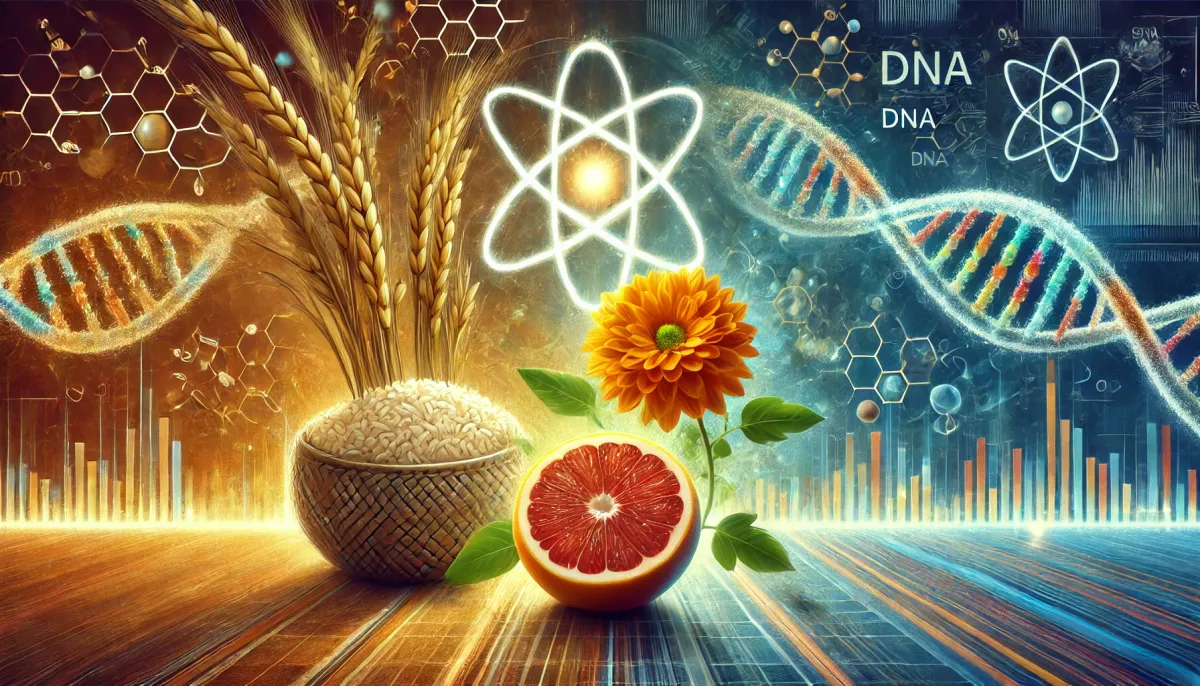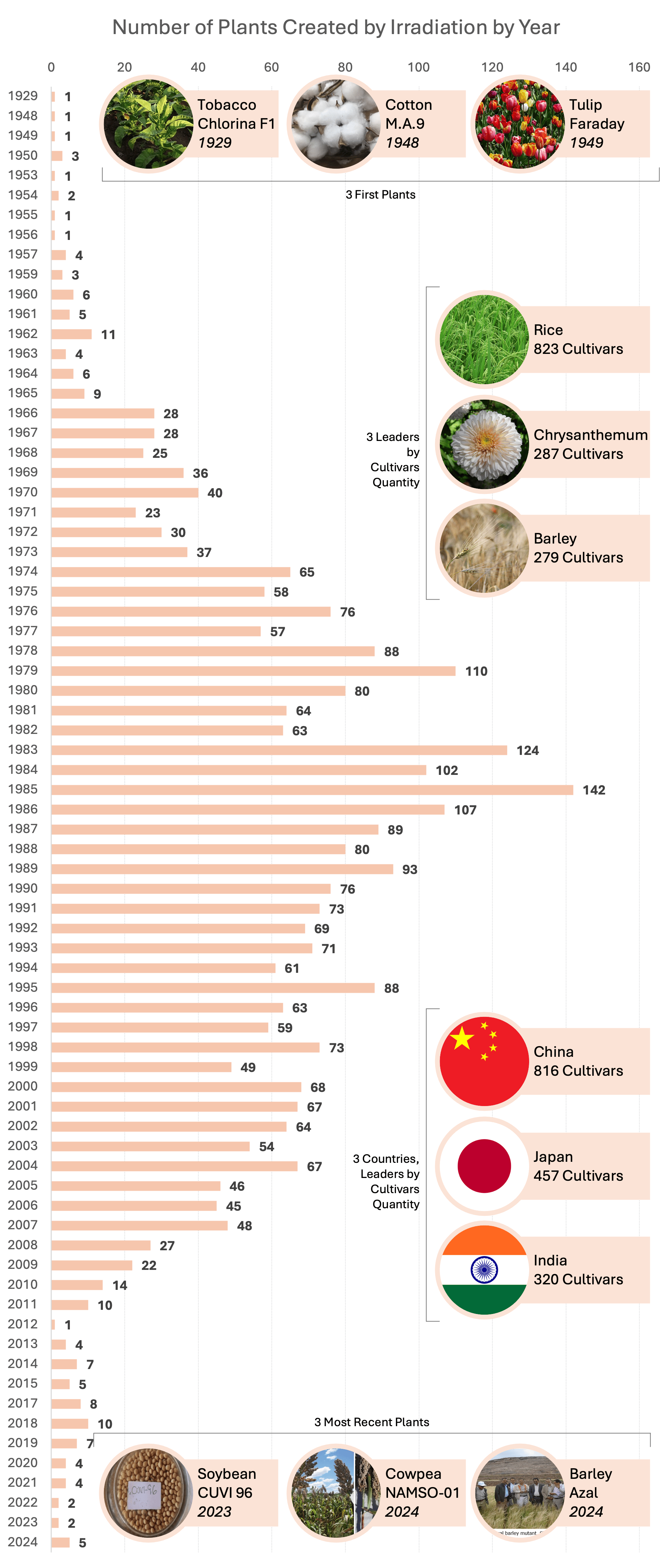Atomic Gardening. Plants Created by Radiation
With the help of radiation, people have created and are creating new plants. Let's see what the scale of this phenomenon is.

Irradiated and Distorted Understanding of Nature
Among the childhood jokes in the post-Soviet space about radiation, one stuck with me: “Come to Chernobyl; we have such big apples”. In a way, this short sentence shaped my not-so-conscious perception of the issue for years. It seemed that fruits and vegetables exposed to radiation would produce irradiated seeds and radioactive offspring unfit for consumption.
A few years ago, I came across a post about atomic gardening, but didn't fully grasp it. My interest in the topic was finally sparked by the book “Life as We Made It” [1]. In it, I came across the following lines:
Brown rice, the popular disease-resistant Renan wheat, and Ruby Red grapefruits are all products of mutation breeding...
At first, I thought it was about grapefruits in general, which is why I was so surprised. I don't like grapefruits; their taste seems too harsh to me. Hence, the thought that they could be created by radiation amused me.
But no, grapefruits are the product of a love affair between an orange and a pomelo [2]. Maybe their brightness attracts the attention of those writing about radiation breeding. However, only two new grapefruit varieties have emerged due to plant irradiation. The first is “Star Ruby”, where the main achieved effect is a reduction in the number of seeds from 40-60 to 0-9. The second is “Rio Red”, and its main improvement is the color of the peel and flesh.
Today, both varieties are available online for purchase. This gives me reason to believe that a dangerous dose of radiation is not inherited.
Atomic Gardening is Far More Extensive Than One Might Imagine
At the end of the previous section, I wrote “only two new varieties”. What does “only” mean? That's two whole varieties created by the dangerous and invisible radiation!
At least, that's what I thought. It turns out that there are 2,977 varieties of plants created using irradiated seeds registered worldwide. Even in 2024, five new varieties of atomic plants appeared.
A Brief History of Atomic Gardening
The first radiation-cultivated plant was approved in 1929. It was approved by the authorities in Indonesia, which was then a Dutch colony. It took a while for gamma gardening to come back — no new irradiated plants appeared until 1948.
From 1945, when atomic bombs were dropped on the cities of Hiroshima and Nagasaki, during the World War II interest in atomic energy and radiation began to grow significantly. It's likely that those dealing with atomic energy wanted it to be associated not only with destruction but also with creation. This led to the search for benefits that could be derived from the new phenomenon.
The results of this search were sometimes quite peculiar. For example, the December 1947 issue of Atomic Energy Research praised the fertile soil in Nagasaki. An illustration of its fertility was sesame seeds twice the size of their “unirradiated” counterparts [3].
It's believed that atomic gardens began to develop particularly actively in the 1950s, when the USA President Dwight Eisenhower's program “Atoms for Peace” [4] was launched. At the same time, it cannot be said that the main atomic states hold the lead in the number of varieties created by radiation. In the USSR and later in the republics after its collapse, 130 varieties were created. In the USA — 114. United Kingdom even with its famous Atomic Gardening Society created only 33 varieties.
The silent leaders in radioactive breeding are China (816 varieties), Japan (457 varieties), and India (320 varieties).
Below is a diagram of new plant registrations by year. In 1985, there was a peak, and then a steady decline began. It seems that the Chernobyl disaster, mentioned at the beginning of the post, led to the decline of radiation breeding.
A Little on the Structure of a Gamma Garden
Gamma gardens used a radiation source, typically cobalt-60, to emit gamma rays that altered the genetic makeup of plants. Usually they looked like concentric circles with radioactive source in their center.
The plants nearest to the radiation source would die, while those further away would exhibit various mutations, allowing researchers to identify beneficial traits and breed new varieties.
Today’s design of atomic plant-mutation experimentation might look different.
Atomic Gardening Today
In the 2020s, irradiation breeding is still being applied. Here are the countries where at least one variety has been cultivated since 2020: China, Namibia, India, Cuba, Yemen, Indonesia. Why is such unusual gardening still used? I'll quote an article from the Atomic Gardens website [5]:
It is no accident that these successes are from countries like Ghana, Peru and Vietnam: gamma gardens are cheap and easy to set up, especially when compared to the techniques and equipment required for high level genetic modification. A new gamma garden–the “Gamma Phytotron” was constructed in Jeongeup, Jeonbuk Korea in 2008, and a “Gamma Greenhouse” in Jalan Dengkil, Malaysia in 2009.
There is much more to tell because the topic is vast. But this is a blog about lists.
So, the Lists of Notable Radiation-Created Plants
All data is taken from the Mutant Variety Database of the International Atomic Energy Agency.
The First:
- Tobacco Chlorine F1. Indonesia, 1929. Main improvements: pale coloration and high-quality leaves.
- Cotton M.A.9. India, 1948. Main improvement: drought resistance.
- Tulip Faraday. Netherlands, 1949. Main improvement: new colors. Unfortunately, which ones are not specified.
The Most Common:
- Rice: 823 varieties.
- Chrysanthemum: 287 varieties.
- Barley: 279 varieties.
The Most Recent:
- Soybean CUVI 96. Cuba, 2023. Main improvements: high productive potential with limited water and chemical fertilizers, as well as white grains ideal for producing milk, yogurt, and cheese.
- Cowpea NAMSO-01 (L7P7-3). Namibia, 2024. Main improvement: increased annual yield from 1 to 2 tons per hectare to 2–3 tons per hectare.
- Barley Azal. Yemen, 2024. Main improvement: resistance to lodging *.
And here is a diagram describing the history of atomic gardening.

Conclusion to the Story of Atomic Gardens
Today, radiation breeding is not as widespread as it was until the mid-1980s. It's not a very reliable tool that, although it speeds up the emergence of mutations, cannot boast great predictability. The development of genetic engineering and man-made disasters influenced the use of atomic energy in agriculture. On the other hand, it cannot be said that the technology has completely disappeared. It has simply found its small niche.
* Lodging [6] — Lodging is the bending over of the stems near ground level of grain crops, which makes them very difficult to harvest, and can dramatically reduce yield.
Was it interesting to read the list of radiation-created plants? Subscribe to the “So List” blog — there are many more amazing lists and checklists in the world. You'll also learn how to solve many issues with these simple yet powerful tools.
List of Links
[1] Beth Shapiro, “Life as We Made It: How 50,000 Years of Human Innovation Refined―and Redefined―Nature”, ISBN 978-1541644182
[2] “Grapefruit” from Wikipedia
[3] “Born from the Bomb” from the “Atomic Gardens” website
[4] “Atomic gardening” from Wikipedia
[5] “The Atomic Garden LIVES!!” from the “Atomic Gardens” website
[6] “Lodging” from Wikipedia



